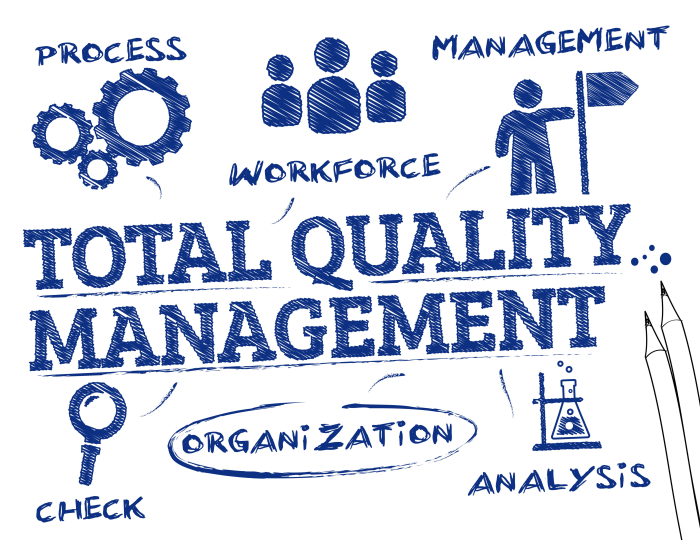
 Data Structure
Data Structure Networking
Networking RDBMS
RDBMS Operating System
Operating System Java
Java MS Excel
MS Excel iOS
iOS HTML
HTML CSS
CSS Android
Android Python
Python C Programming
C Programming C++
C++ C#
C# MongoDB
MongoDB MySQL
MySQL Javascript
Javascript PHP
PHP
- Selected Reading
- UPSC IAS Exams Notes
- Developer's Best Practices
- Questions and Answers
- Effective Resume Writing
- HR Interview Questions
- Computer Glossary
- Who is Who
5 Easy Steps to Implement TQM in a Factory
Total Quality Management (TQM) is a management approach designed to ensure customer satisfaction and organizational success by continuously improving the quality of goods and services produced by a factory. Implementing TQM in a factory setting can be a daunting task; however, the benefits it brings in terms of improved product performance can be worth the effort. In this article, we will discuss the steps needed to implement TQM in a factory as well as the potential benefits it can bring.
What Is TQM?
Total Quality Management (TQM) is a management strategy that aims to improve production performance and increase customer satisfaction. It is a process that involves the entire organization working together to create a culture of continuous improvement to achieve higher levels of efficiency, reliability, and customer satisfaction. TQM focuses on understanding customer needs, streamlining processes, and creating a work environment that encourages employees to work together to continually improve the quality of their products or services. TQM includes a set of practices and principles that aim to ensure quality standards are met and improved upon over time. This includes analyzing customer feedback, tracking performance data, setting goals, implementing corrective action plans, and encouraging employee engagement and innovation. By utilizing these processes, organizations can ensure their products and services are consistently meeting customer expectations and improving overall product performance.

Why Is TQM Important?
Total Quality Management (TQM) is an essential part of any business or organization that strives to be successful and efficient. TQM is a set of practices and strategies that aim to ensure quality throughout all areas of the organization, from production to customer service. It is designed to focus on the needs of customers, improve overall quality and productivity, reduce costs, and increase profitability.
TQM focuses on continuous improvement, which means it encourages organizations to find ways to meet and exceed customer expectations consistently. It seeks to identify areas for improvement and then make changes to processes and procedures to ensure those improvements are successful and sustained. By identifying problems early and correcting them quickly, TQM can help reduce costs and increase customer satisfaction.
The benefits of implementing TQM go far beyond increased quality and cost savings. It also helps create a culture of trust and respect between management and employees, leading to improved morale, better collaboration, and more creative problem-solving. Additionally, TQM encourages experimentation and risk-taking in the pursuit of improvements, leading to greater innovation. Ultimately, these benefits help organizations reach their goals faster and more efficiently.

How Can TQM Be Implemented in A Factory Setting?
To successfully implement TQM in a factory setting, several steps must be taken.
Step 1: Developing The Vision and Mission
The first step is to develop a quality policy statement, which will include the organization's commitment to quality and the methods it plans to use to achieve that goal. This statement should be communicated to all employees and customers so that everyone is aware of the company's commitment to quality.
Step 2: Creating A TQM Plan
The second step is to create a plan that outlines the methods and processes necessary to achieve the desired quality outcomes. This plan should include specific goals and objectives as well as detailed procedures for achieving them. Managers must also identify the success factors that can be critical for the achievement of desired goals. It should also include steps to measure progress toward the objectives.
Step 3: Setting A Flow of Work and Communication
The third step is to create a system of communication between employees, management, and customers. This system should enable feedback on the effectiveness of the implemented measures and allow for the adjustment of any processes or procedures as needed.
Step 4: Establishing Authority and Responsibility
The fourth step is creating teams responsible for implementing and monitoring TQM practices. These teams should be composed of personnel from various departments and levels within the organization. Each team should have specific tasks and responsibilities in order to ensure that quality standards are met.
Step 5: Monitoring The Results and Taking Necessary Steps for Control
Finally, an audit process should be established to assess the effectiveness of the implemented measures. This audit should include an analysis of the current state of the factory's operations as well as an evaluation of customer satisfaction with the organization's products and services. The audit results should be used to make necessary adjustments in order to improve performance and achieve quality goals.
By taking these steps and following through with regular evaluations and assessments, organizations can successfully implement TQM in a factory setting and improve their production performance.
What Are Some Benefits of Implementing TQM?
The implementation of Total Quality Management (TQM) in a factory setting can offer numerous benefits, from improved customer satisfaction to higher productivity. Some benefits that can be reaped from implementing TQM are ?
Improved Quality ? With TQM, factories can identify and eliminate unnecessary costs, reduce waste, increase efficiency, and improve quality.
Improved Customer Satisfaction ? Customers are the lifeblood of any business, and TQM helps factories build strong relationships with their customers. By reducing defects and implementing a continuous improvement process, factories can ensure their customers receive consistently high-quality products that meet their needs and exceed their expectations.
Higher Productivity ? By utilizing the concepts of TQM, factories can become more efficient by eliminating redundant processes, improving communication between departments, and ensuring that resources are used in the most efficient way possible. This can lead to higher productivity as well as reduced costs associated with production.
Reduced Costs ? By applying TQM to its processes, a factory can reduce the amount of scrap and rework it produces. This can significantly reduce the cost of production, which allows the factory to invest in other areas of the business or keep its prices competitive.
Increased Efficiency ? TQM helps factories identify areas where they need to improve and make necessary changes. This can help them streamline processes and become more efficient, leading to improved quality and reduced costs.
Ultimately, TQM is an effective way for factories to increase their competitiveness and remain profitable. Implementing TQM principles can help factories improve customer satisfaction, increase productivity, reduce costs, and improve efficiency.
Conclusion
The implementation of TQM is a way for businesses to stay competitive, increase profits, and provide better customer service. By implementing TQM in their factory setting, organizations can benefit from increased efficiency, better quality control, and improved safety standards. In conclusion, the implementation of TQM is an effective way for companies to maximize production performance and stay ahead of the competition.

